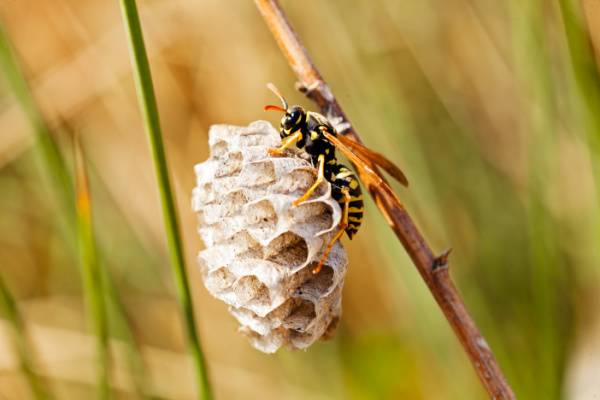Wasp Removal Near Denver
Dealing with any kind of pest can be a headache. Now, stinging pests, on the other hand, is a whole different story. It is quite common, in the Denver, CO region to step outside your front door and find dozens of scary insects buzzing around. You've probably have had to deal with your fair share of wasps, and are on this page looking for help with wasp removal.
Unfortunately, because of their aggressive tendencies, wasps can be notoriously difficult to contain. Your typical wasp will have a stinger, with venom that is transmittable through a sting. The stings are quite painful, cause irritation, and can be especially lethal to people with allergies. What makes wasps even more dangerous is that, unlike bees, they can sting you repeatedly during an attack. And if attacked by a swarm, it can be life-threatening.
Where to Locate Wasps in Your Home
Usually, wasps make their nests inside fixtures or under eaves and soffit. You'll also find them in equipment within your property. In their worst, wasps can invade your home in large colonies, setting up in the attic and roof ceiling board. They are mainly attracted to flowers, leftover meat, and the availability of insects they can prey on. The wasps nests will usually take the shape of half-football shapes with exposed hexagonal looking cells.
Other common places you'll need wasp removal are:
- crawlspaces
- fixtures
- chimneys
- below decks
- beneath rooflines and eaves
- in outdoor lighting fixtures
- rafters
Common Types of Wasps in Denver
Ideally, the first step to pest control is identifying the particular type of insect that is nagging you. Then you can find an appropriate way of dealing with it. At the moment, there are four main species of wasps you'll find in the Denver area.
Yellow Jackets
Distinguished by their distinct yellow and black markings on their bodies, yellow jackets are arguably the most aggressive stinging insects you'll find out there. They're also defined by large colonies, which grow to be extremely large during the summertime.
As you may expect, yellow jackets have a major hand in most stinging related incidences in Denver. Usually, they build their nests under the ground in spaces between rocks and abandoned rodent holes. For food, worker-wasps forage from trash and leftovers in early summer. In late summer, males mate with fertile females, who then hibernate through the winter and start new colonies. The old queens and workers are forced to leave the colony. They rarely survive the winter.
Bald-faced Hornets
Bald-faced hornets are like yellow jackets' larger cousins; only, in this case, they have black and white markings on their bodies. They take on the name hornet because of their size and habits while nesting.
Unlike the yellow jackets, the hornets build their nests in shrubs and trees. Typically, these nests will be oval-shaped made of papery looking material. Most bald-faced nests will be built each season afresh then completely abandoned by the late fall.
Paper Wasps
Paper wasps look similar to yellow jackets but are smaller. Depending on the type of paper wasp, they may be yellow, orange, reddish-brown or dark red with brown wings. Their nests are open-faced and have hexagonal cells. You'll usually find them along playground equipment, soffit areas, and small cavities. Unlike its counterparts, the paper wasp is not that aggressive. However, it can still sting if provoked. Like the other wasp species, paper wasps abandon their nests in the late fall. However, in this case, new queens may build new nests in the same location the following season.
Mud dauber wasps
Mud dauber wasps are black with yellow bands across their legs and body. However, they stand out with distinctively thin bodies, usually separated by an elongated divide between their thorax and abdomen. Mud dauber wasps are the most solitary of the four species. They are not as aggressive as well but can sting if provoked. As their name suggests, mud dauber wasp's build their homes as cells of mud. You'll find them in corners of buildings, under eves and cracks, among other protected areas.
How to Get Rid of Wasps in Denver, CO
When dealing with any stinging insects, you need to exercise utmost caution. If done improperly, it can lead to a swarm of angry pests, followed by multiple painful stings. Needless to say, your ordinary pesticide won't cut it. Instead, you are advised to consult professionals with proper experience and training.
At Croach®, we boast of years of experience in handling stinging insects in Denver, Colorado. Our teams of experts are thoroughly trained to identify the different types of wasps and develop ways of dealing with them, respectively. We specialize in wasp removal and follow-up with prevention techniques that will permanently keep them away.
We take pride in our quick means of handling the pests using unique, specialized, safety-approved and environmentally friendly techniques. So, if you are looking to get rid of wasps in Denver, CO, call us today for a free inspection.
Trusted Pest Control Near Denver
Croach® proudly serves the Front Range of Colorado, including Arvada, Aurora, Boulder, Brighton, Broomfield, Castle Rock, Centennial, Commerce City, Denver, Erie, Frederick, Glendale, Henderson, Hudson, Lakewood, Littleton, Longmont, Loveland, Parker, Thornton, Westminster, and Windsor.
Licensed, Bonded, Insured
CO License #16006



